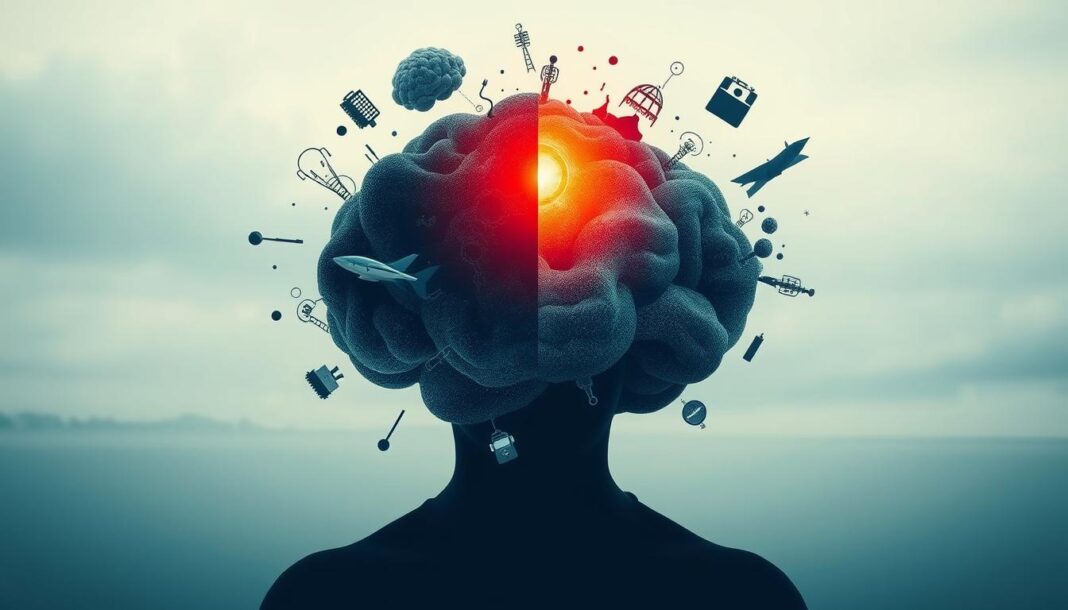Are you feeling overwhelmed by stress or anxiety in your daily life? You’re not alone. Many people deal with these feelings. It’s important to know the difference between stress and anxiety to manage them better.
Feeling stressed or anxious can really affect your life. It’s key to find ways to cope. This article will help you understand these feelings, find what triggers them, and learn strategies to better your mental health.
By using effective coping methods, you can take back control of your life. This will improve your overall well-being.
The Science Behind Stress and Anxiety
Stress and anxiety have both physical and mental sides. When you face stress, your body’s stress response kicks in. It releases hormones like cortisol and adrenaline to help you react.
How Your Body Responds to Stressors
Your body has a complex way of dealing with stress. When you see a threat, your hypothalamus starts the “fight or flight” response. This gets you ready to face or run from danger.
This response includes a faster heart rate, quicker breathing, and tense muscles. These changes help you respond to threats better.
Stress hormones like cortisol are key in this process. Cortisol helps get energy ready, stops non-essential functions, and helps remember stressful events. Knowing this can help you manage your stress response better.
Distinguishing Between Normal and Problematic Anxiety
Anxiety is a normal feeling everyone has sometimes. But, if it’s always there and gets in the way of your life, it’s a bigger problem. Normal anxiety is like worrying a bit before a big event. But, if your anxiety is always there and stops you from living your life, it’s a serious issue.
It’s important to know when your anxiety is normal and when it’s not. If your anxiety is always there, is too much for the situation, or stops you from doing things you need to do, you should get help. Knowing your anxiety symptoms can help you find the right way to deal with them.
The Long-term Impact of Chronic Stress on Your Health
Chronic stress effects can harm your body and mind. Stress hormones like cortisol can cause high blood pressure, heart disease, and weaken your immune system. Chronic stress can also lead to depression and anxiety.
Managing stress well is key to staying healthy. By understanding the chronic stress effects and using good ways to cope, you can reduce these risks and feel better overall.
Identifying Your Personal Stress Triggers
To tackle stress and anxiety, it’s key to know what triggers them. Your stress triggers are specific events, situations, or thoughts that make you feel stressed or anxious. By understanding these triggers, you can find better ways to manage your stress.
Common External Stressors in Modern American Life
External stressors are things outside your control that cause stress. In today’s America, common ones include work-life balance, financial worries, relationship issues, and too much news or social media. For example, tight deadlines at work or juggling home duties can be stressful. Financial stress is also a big worry, with many fretting about bills, saving, or debt.
Internal Thought Patterns That Fuel Anxiety
While you can’t control all external stressors, your thoughts play a big part in how you handle them. Negative thinking, like catastrophizing or all-or-nothing thinking, can make anxiety worse. For instance, if you tend to catastrophize, you might overthink a small problem, making it feel bigger. It’s important to recognize and challenge these thoughts to manage anxiety.
How to Track and Analyze Your Stress Responses
Tracking your stress responses is key to figuring out your personal stress triggers. By watching how you react in different situations, you can spot patterns and find ways to reduce stress. One good way to track stress is by using a stress journal.
Creating an Effective Stress Journal
A stress journal is a tool to record stressful events, your reactions, and any feelings or thoughts that follow. To make a good stress journal, write down the date, time, and details of the stressful event. Also, note your physical and emotional responses. This helps you see your stress triggers and patterns more clearly.
Recognizing Patterns in Your Anxiety Triggers
After keeping a stress journal for a bit, you can start to see patterns in your anxiety triggers. Look for common themes or situations that always stress you out. By spotting these patterns, you can create specific strategies to handle your stress better. For example, if you find you get stressed at certain times or in specific situations, you can prepare for those moments.
Quick-Relief Techniques for Acute Anxiety
Acute anxiety can feel overwhelming. But, there are quick ways to calm your mind and body. When you’re stressed, your body goes into “fight or flight” mode. This releases stress hormones like cortisol and adrenaline.
While these responses are natural, they can be overwhelming if not managed.
Powerful Breathing Exercises You Can Do Anywhere
One simple way to calm your nervous system is through breathing exercises. Deep, controlled breathing can slow your heart rate and lower stress hormones. Try inhaling deeply through your nose for a count of four, holding for seven, and exhaling slowly through your mouth for eight. Do this a few times to feel calm.
Another good technique is “box breathing.” Breathe in for four counts, hold for four, exhale for four, and hold again for four. This creates a “box” shape with your breath, promoting balance and calmness.
5-4-3-2-1 Grounding Technique for Panic Moments
The 5-4-3-2-1 grounding technique is great for managing acute anxiety and panic attacks. It helps you focus on the present by engaging your senses. Start by noticing:
Five things you can see around you.
Four things you can touch or feel.
Three things you can hear.
Two things you can smell.
One thing you can taste.
This technique distracts you from anxious thoughts and grounds you in the present. It reduces panic feelings.
Progressive Muscle Relaxation: A Step-by-Step Guide
Progressive muscle relaxation (PMR) involves tensing and relaxing different muscle groups. Start with your toes and move up to your head, tensing each group for a few seconds before releasing. This releases physical tension and promotes relaxation.
For example, tense your toes for five seconds, then release. Move up through the body, tensing and relaxing each muscle group.
Mindfulness Practices to Center Your Thoughts
Mindfulness means paying attention to the present moment without judgment. It helps you become more aware of your thoughts and feelings. This makes it easier to manage anxiety. Try focusing on your breath or a mantra, observing your thoughts without engaging with them.
Regular mindfulness practice can lower overall anxiety levels. It also improves your ability to handle stressful situations.
Stress and Anxiety: Deciding How to Cope With or Manage Stressors
Managing stress starts with knowing what stresses you and how to handle it. It’s key to have a plan to deal with stress and anxiety.
Distinguishing Between Controllable and Uncontrollable Stressors
First, figure out what you can control and what you can’t. Controllable stressors are things you can change, like your job or friends. Uncontrollable stressors are things you can’t change, like the economy or natural disasters.
Knowing the difference helps you focus on what you can change. This way, you feel less overwhelmed and more in control.
Creating Your Personalized Stress Management Strategy
Creating a personalized stress management strategy means looking at how you cope now and what you can improve. It’s about finding the best ways to handle stress for you.
Assessing Your Current Coping Methods
Start by looking at how you deal with stress. Ask if your methods are good for you. Keep a journal to track when you’re stressed and how you react.
Implementing New Techniques Gradually
After looking at your current ways, start adding new ones. Start small, like with deep breathing exercises or short meditation sessions every day.
Setting Healthy Boundaries in Work and Relationships
Setting healthy boundaries is key for stress management in work and life. Learn to say “no” to things that don’t fit your priorities or take away from your time.
Clear boundaries help protect your time and energy. They reduce stress and improve your well-being.
Recognizing When It’s Time to Seek Professional Support
While you can manage stress on your own, sometimes you need professional support. If stress and anxiety are too much, it’s time to see a mental health expert.
Seeking help is a sign of strength, not weakness. It shows you’re taking steps to improve your mental health.
Lifestyle Modifications That Reduce Anxiety Naturally
You can naturally ease anxiety by making a few simple changes in your daily life. These adjustments can greatly improve your mental and physical health. They help you handle stress and anxiety better.
Exercise Routines That Combat Stress Hormones
Regular exercise is a great way to fight anxiety. It cuts down stress hormones like cortisol and adrenaline. It also releases endorphins, which make you feel better.
Try to exercise for at least 30 minutes, most days. Good choices include brisk walking, cycling, or swimming.
Even gentle activities like yoga or tai chi can help. They promote relaxation and boost your mood.
Nutrition Strategies to Stabilize Mood and Energy
What you eat affects your anxiety. Eating a balanced diet with whole foods can help. Include fruits, vegetables, whole grains, lean proteins, and healthy fats.
Foods That May Trigger Anxiety
Some foods can make anxiety worse. Watch your intake of caffeine, alcohol, and processed foods. They can trigger or worsen anxiety in some people.
Mood-Boosting Dietary Choices
Eating mood-boosting foods can help with anxiety. Foods like salmon and walnuts are good for your mental health. Whole grains can also help by boosting serotonin in your brain.
| Food | Nutritional Benefit | Potential Anxiety-Related Benefit |
|---|---|---|
| Salmon | Rich in Omega-3 fatty acids | May reduce inflammation and promote brain health |
| Walnuts | High in Omega-3 fatty acids and antioxidants | Supports brain health and may reduce anxiety symptoms |
| Oatmeal | Complex carbohydrate source | Can help increase serotonin levels, promoting relaxation |
Sleep Optimization for Better Stress Resilience
Good sleep is key to managing anxiety. Bad sleep can make anxiety worse. But, good sleep habits can help you handle stress better.
Stick to a regular sleep schedule. Create a calming bedtime routine. Make your sleep area comfortable. Avoid screens and exciting activities before bed.
Practical Time Management to Prevent Overwhelm
Managing your time well is important to avoid feeling overwhelmed. Prioritize tasks and break big projects into smaller ones. Use to-do lists or calendars to stay organized.
Say “no” to things you don’t need to do. Set achievable goals for each day. This can reduce stress and prevent feeling overwhelmed.
Creating Daily Rituals That Promote Calm
Daily rituals can bring structure and calm to your life. Try meditation, journaling, or deep breathing exercises. They can be very helpful.
Adding mindfulness to your daily routine is also beneficial. It helps you stay in the moment and reduces worries about the past or future.
Cognitive Strategies to Transform Your Relationship with Anxiety
Cognitive strategies are a powerful tool for those wanting to change their relationship with anxiety. They help improve mental well-being. By using these strategies, you can lessen anxiety’s impact on your life.
Identifying and Challenging Negative Thought Patterns
Managing anxiety starts with spotting and fighting negative thoughts. These thoughts, or cognitive distortions, can make anxiety worse. They include catastrophizing and all-or-nothing thinking.
To fight these thoughts, keep a thought journal. Note situations that make you anxious, your thoughts, and feelings. Then, check if these thoughts are true or if there are better ways to see things.
| Distorted Thought | Reality Check | Balanced Thought |
|---|---|---|
| “I’ll never be able to do this.” | “Have I succeeded in similar tasks before?” | “I’ve faced challenges before and succeeded; I can do it again.” |
| “This is a disaster.” | “Is it really a disaster or just a setback?” | “It’s a setback, but I can learn from it and move forward.” |
Practical Cognitive Behavioral Techniques for Daily Use
Cognitive Behavioral Therapy (CBT) techniques are great for anxiety. Cognitive restructuring helps by changing negative thoughts to balanced ones. Exposure therapy involves facing what scares you, starting with the least scary.
Try mindfulness meditation for daily use. It helps you stay in the moment, aware of thoughts and feelings without getting caught up.
Developing a Growth Mindset About Stress
A growth mindset sees challenges as growth chances, not threats. This mindset makes you more resilient. Focus on the process, not just the outcome, and see failures as learning chances.
Effective Use of Positive Self-Talk and Affirmations
Positive self-talk and affirmations can change your mental state. Use positive, present-tense, personal affirmations. For example, “I am capable of handling whatever comes my way” boosts confidence and reduces anxiety.
Professional Treatment Options for Anxiety Disorders
If you’re dealing with anxiety disorders, knowing about professional treatment options is key. These disorders can really affect your daily life. While self-help is helpful, professional help is often needed for real relief.
There are many professional treatment options for anxiety disorders. These include different therapy approaches, medications, and complementary treatments. The right treatment depends on your specific needs, how severe your symptoms are, and what you prefer.
Understanding Different Therapy Approaches
Therapy is a big part of treating anxiety disorders. Different therapies can help you understand and manage your anxiety.
Cognitive Behavioral Therapy (CBT)
CBT is a top treatment for anxiety disorders. It helps you change negative thoughts and behaviors that cause anxiety. You learn new, better ways to think and act.
Acceptance and Commitment Therapy (ACT)
ACT is another proven therapy. It teaches you to accept your thoughts and feelings. At the same time, it encourages you to act in ways that match your values. This helps reduce anxiety’s impact on your life.
Other Evidence-Based Approaches
Therapies like Dialectical Behavior Therapy (DBT) and Psychodynamic Therapy can also help. The important thing is to find a therapist and approach that suits you.
Medication Options and Considerations
For some, medication is part of the treatment plan. SSRIs and benzodiazepines can help with anxiety symptoms. But, it’s important to talk about the good and bad sides with your doctor.
Complementary and Alternative Treatments
Along with traditional therapies and meds, there are other treatments that can help.
Mindfulness-Based Stress Reduction (MBSR)
MBSR uses mindfulness and stress reduction to help manage anxiety. It teaches you to stay in the present and not worry about the past or future.
Acupuncture and Other Holistic Approaches
Acupuncture and holistic practices like yoga and meditation can also help. They focus on the connection between your body and mind.
Always talk to a healthcare professional before trying new treatments, including alternative ones.
Building Your Stress Resilience Support Network
Dealing with stress and anxiety can be tough. But having a strong support network can really help. This network gives you emotional support, practical help, and a sense of belonging. All these are key to building your stress resilience.
The Powerful Role of Social Connections in Anxiety Reduction
Social connections are key in fighting anxiety. A strong support system helps you deal with stress better. Social connections make you feel less alone and more supported. This can lower your anxiety levels.
Studies show that people with good social connections have less stress and anxiety. Your support network can offer emotional, informational, and practical help. Emotional support is about feeling understood, informational support gives advice, and practical support helps with daily tasks.
How to Communicate Your Needs to Friends and Family
Telling friends and family about your stress and anxiety is crucial. Being open and honest helps them understand you better. Start by sharing your feelings and needs clearly, using “I” statements to express your emotions without blaming.
For example, you might say, “I feel overwhelmed with tasks. Can you help me sort them out or do some for me?” This way, your loved ones know how to support you.
Finding Community Resources and Support Groups
There are also community resources and support groups to help with stress and anxiety. These places offer a safe space to share, get support, and learn from others facing similar issues.
Look online for local support groups, mental health organizations, or community centers with stress management programs. Joining a support group can connect you with others who get what you’re going through. It makes you feel less alone and more supported.
Conclusion
Managing stress and anxiety is key for your well-being. It’s important to know what causes stress and find ways to cope. By using the strategies we talked about, you can create a stress management plan that fits you.
There are many ways to deal with anxiety, like quick fixes, changing your lifestyle, thinking differently, and getting professional help. Having a strong support network is also crucial. By using these methods every day, you can boost your mental health and life quality.
Remember, managing stress and anxiety is an ongoing journey. Stick to your plan and ask for help when you need it. With the right tools and support, you can face life’s challenges with confidence and strength.



